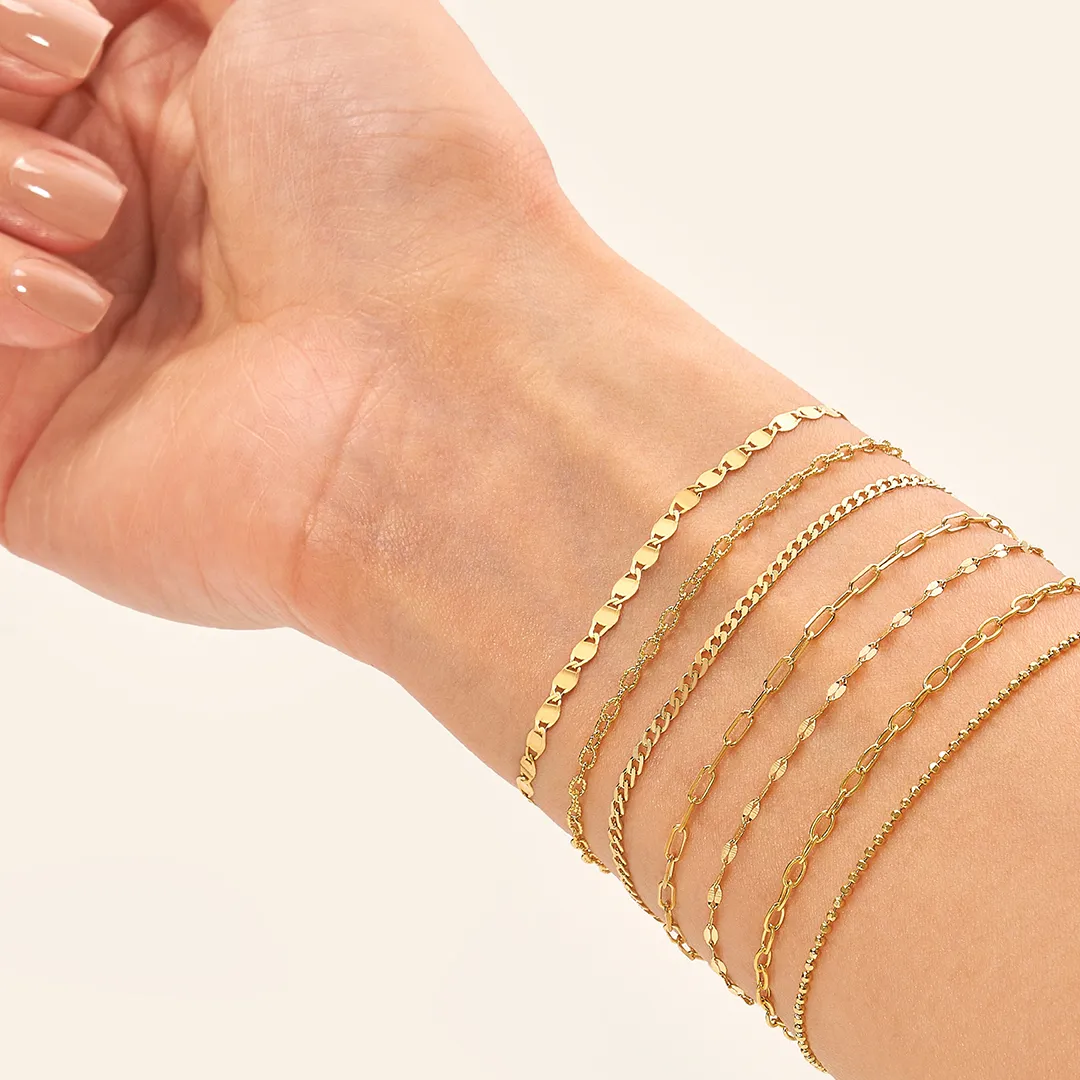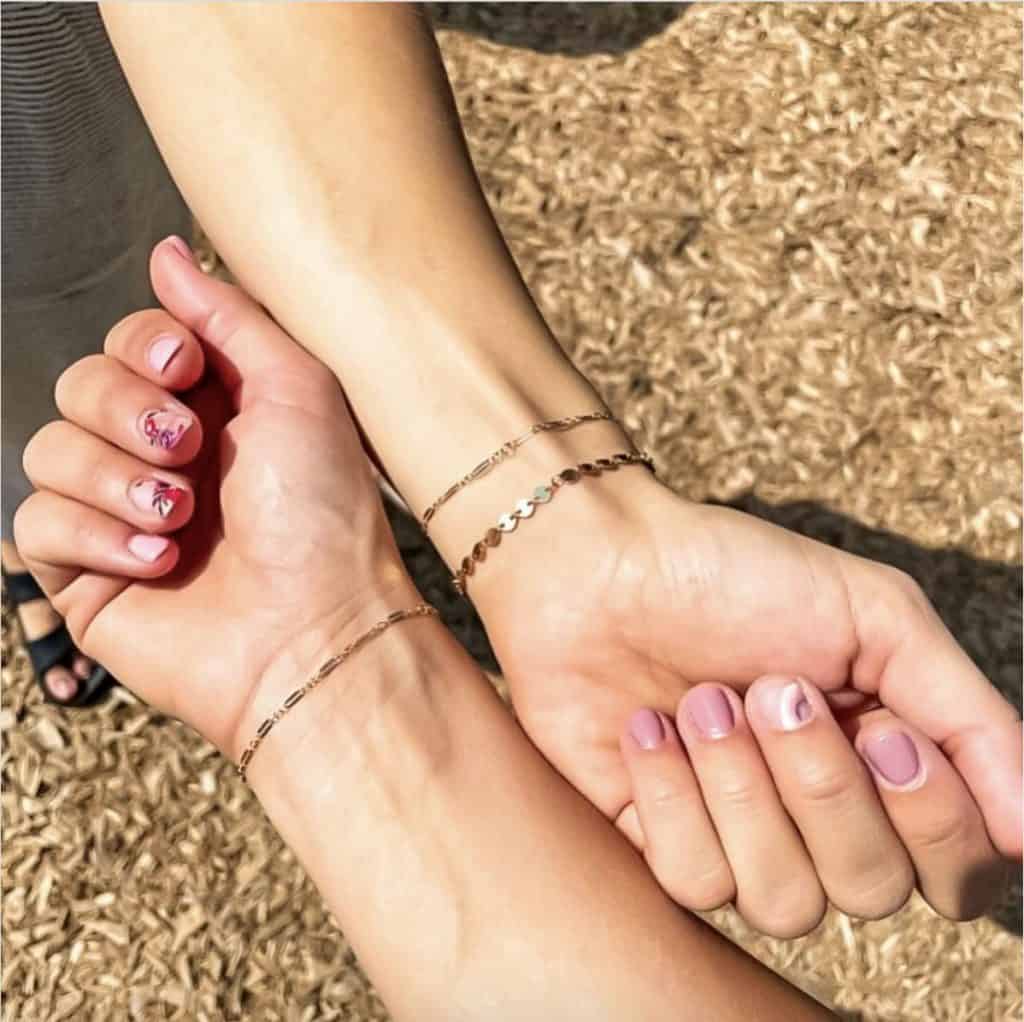In the ever-evolving world of fashion and self-expression, a new trend has emerged, captivating individuals seeking a unique and enduring form of adornment: permanent jewelry. Unlike traditional jewelry that can be easily removed and replaced, permanent jewelry, such as bracelets, anklets, necklaces, and rings, is custom-fitted and seamlessly welded or clasped onto the wearer, creating a permanent bond (or at least one that’s meant to last). This seemingly simple concept has ignited a firestorm of interest, transforming the way people perceive and interact with their accessories. Its appeal stems from a desire for low-maintenance style, a symbol of commitment, and a way to personalize one’s look. The increasing popularity of permanent jewelry reflects a broader shift toward minimalist aesthetics, personalized experiences, and a rejection of fast fashion’s disposable nature.
The current context for permanent jewelry is particularly interesting. Social media platforms, particularly Instagram and TikTok, have played a significant role in popularizing this trend. Influencers and celebrities showcasing their permanent jewelry have driven awareness and demand. Furthermore, the rise of small businesses and pop-up shops specializing in permanent jewelry services has made it increasingly accessible. It is no longer a niche concept but a mainstream trend, embraced by diverse demographics. The rise of permanent jewelry also coincides with a growing interest in sustainable and ethical practices. Choosing a piece of jewelry meant to last a lifetime aligns with a more conscious consumerism mindset, reducing the need for frequent purchases and the environmental impact associated with mass-produced accessories.

The allure of permanent jewelry is multi-faceted. It is a statement of commitment, a symbol of love, friendship, or self-love. The permanent nature of the jewelry makes it a lasting reminder of a special occasion or a significant relationship. The minimalist aesthetic of many permanent jewelry pieces appeals to those seeking a subtle yet impactful form of adornment. The experience of getting permanent jewelry is also an important factor. The customization process, the communal aspect of getting it done with friends, and the feeling of exclusivity contribute to its popularity. This comprehensive exploration delves deep into the world of permanent jewelry, examining its origins, processes, benefits, potential challenges, and its future in the world of fashion and personal expression.
What Exactly Is Permanent Jewelry? Unveiling the Details
Permanent jewelry is, at its core, jewelry that is designed to be worn continuously. This means it doesn’t have a clasp or any other means of easy removal. Instead, it is custom-fitted and connected by welding or a specific clasping technique. The most common forms of permanent jewelry include bracelets, anklets, necklaces, and rings. The appeal lies in its permanence, the sense of effortless style it provides, and the symbolic weight it carries. It’s a departure from traditional jewelry, where pieces are frequently changed to match outfits or moods. With permanent jewelry, the focus is on a singular, lasting piece that becomes an integral part of the wearer’s identity. The materials used are often chosen for their durability and resistance to wear and tear, ensuring the jewelry can withstand daily activities.
The Process of Getting Permanent Jewelry
The process of getting permanent jewelry is typically straightforward and relatively quick. First, the customer selects the type of jewelry they want, choosing from various materials, such as gold, sterling silver, or gold-filled chains. Then, the jeweler measures the area where the jewelry will be placed – typically the wrist or ankle for bracelets or anklets. The chain is then cut to the precise size, ensuring a comfortable and secure fit. The joining method is the defining aspect: either welding or clasping.
Welding Technique
Welding is the most common method for creating truly permanent jewelry. The jeweler uses a small, specialized welding tool to fuse the ends of the chain together. This process involves a brief, focused burst of heat to melt the metal and create a seamless connection. Safety is paramount, and the jeweler will take precautions to protect the customer’s skin and eyes during the welding process. The entire procedure, including the selection, measurement, and welding, typically takes around 15-30 minutes.
Clasping Technique
An alternative to welding involves a small, permanent clasp. While not technically “permanent” in the same sense as welding, it’s designed to be very difficult to remove without tools. This method is often preferred by those who may need to remove their jewelry for specific reasons, such as medical procedures or work requirements. The clasping technique involves using a specialized jump ring and a small clasp that securely joins the chain ends. This method offers more flexibility compared to welding, but it still provides a lasting and secure fit.
Regardless of the joining method, the process is generally pain-free and safe when performed by a trained professional. It’s important to choose a reputable jeweler who uses high-quality materials and follows proper safety protocols. The jeweler will also provide aftercare instructions to ensure the longevity of the jewelry and prevent any potential complications.
Materials and Styles
The materials used in permanent jewelry are critical to its longevity and aesthetic appeal. Gold is a popular choice, known for its durability, luxurious appearance, and resistance to tarnish. Sterling silver offers a more affordable alternative, though it requires more care to prevent tarnishing. Gold-filled chains are also a common option, providing a cost-effective way to achieve the look of solid gold. These materials are selected for their strength and ability to withstand daily wear and tear.
The style options for permanent jewelry are diverse, ranging from delicate, minimalist chains to more elaborate designs incorporating charms or gemstones. The choice of style often reflects the wearer’s personal preferences and the desired aesthetic. Here are some common styles:
- Simple Chains: These are the most popular and versatile options, consisting of delicate chains in various styles, such as cable, curb, or rope.
- Charms: Charms add a personalized touch to permanent jewelry. They can be initials, symbols, or small pendants that hold special meaning.
- Gemstones: Tiny gemstones, such as diamonds or birthstones, can be incorporated into the chain or used as a focal point.
- Layering: Many people choose to layer multiple permanent bracelets or necklaces for a more customized look.
The jeweler will often work with the customer to design a piece that perfectly suits their style. This customization is one of the key appeals of permanent jewelry, allowing individuals to create a truly unique and personal accessory.
Benefits and Considerations of Permanent Jewelry
The appeal of permanent jewelry extends beyond its aesthetic qualities. It offers a range of practical and symbolic benefits that contribute to its growing popularity. However, it’s also important to consider the potential challenges and drawbacks before committing to a permanent piece.
Advantages of Permanent Jewelry
One of the primary benefits of permanent jewelry is its convenience. There’s no need to worry about taking it on and off, misplacing it, or matching it to an outfit. It’s a low-maintenance accessory that simplifies your daily routine. This is particularly appealing to those who prefer a minimalist lifestyle or who lead active lives.
Permanent jewelry also offers a sense of symbolism and personal connection. It can represent a lasting commitment, such as a friendship, a relationship, or a commitment to self-love. Many people choose to get permanent jewelry with loved ones, creating a shared symbol of their bond. It can also serve as a daily reminder of a special event or a personal goal.
From an aesthetic point of view, permanent jewelry provides a seamless and effortless style. It can be a subtle yet impactful way to enhance your overall look. The minimalist aesthetic of many permanent jewelry pieces makes them versatile enough to complement any outfit. Moreover, the customization options allow individuals to create a truly unique and personal accessory that reflects their individual style.
Potential Challenges and Considerations
While permanent jewelry offers many advantages, there are also some potential challenges to consider. One of the primary concerns is the permanence itself. Since the jewelry is designed to be worn continuously, it’s important to be certain about your choice and style. Removing the jewelry requires specialized tools and may leave a small mark.
Another consideration is the cost. Permanent jewelry can be more expensive than traditional jewelry, particularly when using high-quality materials like solid gold. The price reflects the labor involved in custom fitting and welding or clasping the piece. It’s essential to factor this cost into your decision and to ensure you’re choosing a reputable jeweler who uses quality materials.
Allergies and skin sensitivity are also potential issues. If you have sensitive skin or are allergic to certain metals, it’s crucial to choose hypoallergenic materials, such as solid gold or titanium. Always inquire about the materials used and ensure they are safe for your skin. Consider also the possibility of needing to remove the jewelry for medical reasons. While rare, there might be situations where removal is necessary.
It’s also important to consider lifestyle factors. If your job requires you to remove jewelry frequently, or if you engage in activities that could damage the jewelry, permanent jewelry might not be the best choice. Carefully evaluate your lifestyle and ensure that permanent jewelry aligns with your daily routine.
Real-World Examples and Case Studies
The rise of permanent jewelry has been documented in various case studies and articles. For instance, many jewelry boutiques have seen a significant increase in demand for permanent jewelry services, particularly among younger demographics. One study found that a majority of customers reported getting permanent jewelry as a symbol of friendship or a special occasion. Another study highlighted the growing trend of couples getting matching permanent bracelets as a modern alternative to traditional wedding bands.
Expert insights from jewelers suggest that the key to success in the permanent jewelry business is to provide a high-quality service and to educate customers about the process and potential challenges. Jewelers emphasize the importance of using durable materials, ensuring proper fitting, and providing clear aftercare instructions. This focus on customer satisfaction and safety is crucial for building a successful and reputable business in this growing market.
Practical Applications and Advice for Permanent Jewelry
Permanent jewelry isn’t just a trend; it’s a lifestyle choice. Understanding how to make the most of this experience, from selecting the right piece to caring for it, is essential. Here’s a practical guide to help you navigate the world of permanent jewelry.
Choosing Your Piece
Material Selection is the first step. Consider your budget, lifestyle, and potential skin sensitivities. Gold is a classic and durable choice, while sterling silver offers a more affordable option but requires more care to prevent tarnishing. Gold-filled is a cost-effective alternative. Ensure the material is hypoallergenic if you have sensitive skin.
Style and Design are next. Think about your personal style and what you want to express. Do you prefer a minimalist chain, a charm, or a gemstone? Consider layering multiple pieces for a more personalized look. Browse examples online and consult with a jeweler to explore the available options.
Finding a Reputable Jeweler is crucial. Research jewelers in your area and read reviews. Check for certifications and ensure they use high-quality materials and follow proper safety protocols. Ask about their welding or clasping techniques and aftercare instructions. Consider going to a jeweler that specializes in this form of jewelry, as they will be best equipped to answer your questions.
Caring for Your Permanent Jewelry
Cleaning and Maintenance are important. Clean your jewelry regularly with a soft cloth and mild soap and water. Avoid harsh chemicals and abrasive cleaners. For sterling silver, use a silver polish to remove tarnish. The frequency of cleaning depends on your lifestyle and how much the jewelry is exposed to dirt and grime.
Safety Precautions are essential. While permanent jewelry is designed to be durable, it’s still important to take precautions. Avoid wearing your jewelry during activities that could damage it, such as heavy lifting or sports that involve impact. Be mindful of potential snagging hazards. If you notice any issues, such as a broken chain or a loose charm, contact your jeweler immediately.
Removal and Repair should be considered. If you need to remove your jewelry, consult with your jeweler. They have the proper tools and expertise to do so safely. Do not attempt to remove it yourself, as you could damage your skin. If your jewelry is damaged, the jeweler can often repair it. This is another reason to choose a reputable jeweler.
Actionable Advice
- Do Your Research: Before getting permanent jewelry, research different materials, styles, and jewelers.
- Set a Budget: Determine how much you’re willing to spend on the jewelry.
- Consider Your Lifestyle: Evaluate your daily activities and how they might affect your jewelry.
- Ask Questions: Don’t hesitate to ask the jeweler about the materials, process, and aftercare.
- Choose a Trusted Jeweler: Select a jeweler with a good reputation and experience.
Summary: The Enduring Allure of Permanent Jewelry
Permanent jewelry has emerged as a captivating trend, representing more than just an accessory; it’s a statement of personal expression and enduring commitment. This comprehensive exploration has delved into the core aspects of permanent jewelry, highlighting its unique appeal and the factors driving its popularity. From the custom fitting process to the diverse material and style options, the allure of permanent jewelry is multi-faceted.
The convenience and symbolic weight of permanent jewelry contribute significantly to its appeal. It simplifies daily routines while also representing meaningful relationships or self-love. The minimalist aesthetic, combined with the ability to customize pieces, allows wearers to create a truly unique accessory. However, the permanence and cost should be carefully considered before making a decision. Potential challenges include the long-term commitment and the need for careful selection of materials and jewelers.
Choosing the right piece involves careful consideration of materials, style, and the reputation of the jeweler. Proper care and maintenance, including regular cleaning and safety precautions, are crucial for preserving the longevity and beauty of the jewelry. The actionable advice provided, such as researching jewelers, setting a budget, and considering lifestyle factors, empowers individuals to make informed decisions and enjoy their permanent jewelry for years to come. The increasing popularity of permanent jewelry is a testament to the evolving landscape of fashion and personal expression.
In essence, permanent jewelry offers a compelling blend of style, convenience, and symbolism. It represents a lasting commitment and a unique way to express individuality. As the trend continues to evolve, it’s essential to approach it with a clear understanding of the process, the benefits, and the potential challenges. By making informed choices, individuals can embrace the enduring allure of permanent jewelry and enjoy a truly personalized and lasting accessory.
Frequently Asked Questions (FAQs)
What materials are typically used for permanent jewelry?
Common materials include gold, sterling silver, and gold-filled chains. Gold is a popular choice for its durability and luxurious appearance, while sterling silver is a more affordable option. Gold-filled chains offer a cost-effective way to achieve the look of solid gold. The choice of material often depends on budget, personal preference, and potential skin sensitivities. It’s important to ensure the material is hypoallergenic if you have sensitive skin.
How long does the process of getting permanent jewelry take?
The process is usually quick and efficient. From selection and measurement to welding or clasping, the entire process typically takes around 15-30 minutes. This includes choosing your chain, getting measured, and having the chain welded or clasped onto your wrist or ankle. The jeweler will also provide aftercare instructions and answer any questions you may have. The time can vary slightly depending on the jeweler and the complexity of the design.
Can permanent jewelry be removed if needed?
Yes, permanent jewelry can be removed, but it requires specialized tools and should be done by a professional jeweler. Do not attempt to remove the jewelry yourself, as you could damage your skin or the jewelry. The jeweler will carefully cut the chain at the weld or clasp. Removal may leave a small mark, but it is generally a safe procedure. The decision to remove the jewelry should be carefully considered, given its permanent nature.
Is permanent jewelry safe for those with sensitive skin or allergies?
Yes, but it’s crucial to choose hypoallergenic materials. Solid gold and titanium are generally safe options for people with sensitive skin or allergies. Before getting permanent jewelry, inform the jeweler about any known allergies or sensitivities. Ask about the materials used and ensure they are nickel-free or free of any other allergens. It’s always best to err on the side of caution and select materials that are known to be gentle on the skin.
How do I care for my permanent jewelry?
Caring for your permanent jewelry is relatively simple. Clean your jewelry regularly with a soft cloth and mild soap and water. Avoid harsh chemicals and abrasive cleaners. For sterling silver, use a silver polish to remove tarnish. Be mindful of potential snagging hazards and avoid wearing your jewelry during activities that could damage it. If you notice any issues, contact your jeweler for repair or assistance. Regular cleaning and proper care will help to maintain the beauty and longevity of your permanent jewelry.



